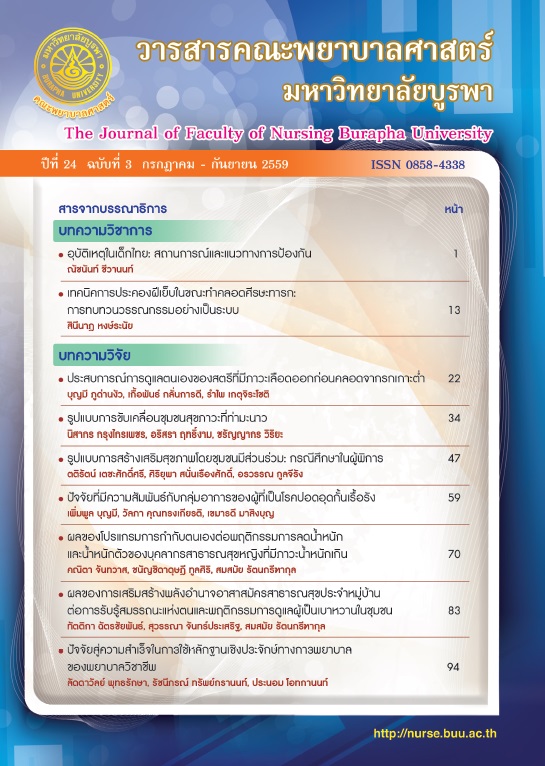ปัจจัยสู่ความสำเร็จในการใช้หลักฐานเชิงประจักษ์ทางการพยาบาล ของพยาบาลวิชาชีพ
คำสำคัญ:
ปัจจัยสู่ความสำเร็จ, หลักฐานเชิงประจักษ์, พยาบาลวิชาชีพ, Factors leading to success, evidence based practice, professional nursesบทคัดย่อ
บทคัดย่อ
การวิจัยครั้งนี้มีวัตถุประสงค์เพื่อศึกษาปัจจัยสู่ความสำเร็จในการใช้หลักฐานเชิงประจักษ์ทางการพยาบาลของพยาบาลวิชาชีพโดยใช้เทคนิคเดลฟาย ผู้ให้ข้อมูลคือผู้เชี่ยวชาญ จำนวน 17 คน ได้มาจากการคัดเลือกแบบเจาะจง 5 คน และวิธีบอกต่อ 12 คน จากคุณสมบัติ ได้แก่ เป็นผู้เชี่ยวชาญทางการพยาบาลที่ปฏิบัติงานเป็นอาจารย์ประจำคณะพยาบาลศาสตร์ในมหาวิทยาลัยหรือวิทยาลัย สำเร็จการศึกษาระดับปริญญาเอก และมีผลงานทางวิชาการและ/หรือมีประสบการณ์เกี่ยวกับการปฏิบัติการพยาบาลตามหลักฐานเชิงประจักษ์ เครื่องมือที่ใช้ในการวิจัย ได้แก่ แนวทางการสัมภาษณ์ที่ผู้วิจัยสร้างขึ้น การดำเนินการวิจัยแบ่งเป็น 2 ขั้นตอน (1) ศึกษาและวิเคราะห์เอกสารเพื่อนำสาระที่ได้มากำหนดกรอบแนวคิดในการวิจัยและกรอบการสัมภาษณ์ (2) การสัมภาษณ์ผู้เชี่ยวชาญ จำนวน 3 รอบ โดยรอบที่ 1 เพื่อระบุปัจจัยสำคัญที่ทำให้พยาบาลใช้หลักฐานเชิงประจักษ์ในการปฏิบัติการพยาบาล แล้วนำข้อมูลไปจัดกลุ่มจัดทำเป็นแบบสอบถามแบบประมาณค่า 5 ระดับ รอบที่ 2 นำแบบสอบถามแบบมาตรประมาณค่าที่ได้จากรอบที่ 1 ไปให้ผู้เชี่ยวชาญตอบแบบสอบถามแล้วนำข้อมูลที่ได้มาวิเคราะห์หาค่ามัธยฐานและค่าพิสัยระหว่างควอไทล์ รอบที่ 3 นำข้อมูลในรอบที่สองมาสรุปแล้วนำไปให้ผู้เชี่ยวชาญยืนยันความคิดเห็นอีกครั้ง หลังจากนั้นนำข้อมูลที่ได้มาวิเคราะห์เพื่อหาข้อสรุป โดยกำหนดค่าที่ยอมรับได้ต้องมีค่ามัธยฐานเท่ากับหรือมากกว่า 3.50 และมีค่าพิสัยระหว่างควอไทล์น้อยกว่า 1.50
ผลการวิจัยพบว่า ปัจจัยสู่ความสำเร็จในการใช้หลักฐานเชิงประจักษ์ทางการพยาบาลของพยาบาลวิชาชีพ ประกอบด้วย 6 ปัจจัย 37 องค์ประกอบ คือ (1) ปัจจัยด้านลักษณะองค์กร มี 9 องค์ประกอบ (2) ปัจจัยด้านลักษณะของผู้บริหารทางการพยาบาล มี 3 องค์ประกอบ (3) ปัจจัยด้านลักษณะของพยาบาลวิชาชีพ มี 13 องค์ประกอบ (4) ปัจจัยด้านลักษณะของสิ่งอำนวยความสะดวก มี 4 องค์ประกอบ (5) ปัจจัยด้านคุณภาพของงานวิจัยและหลักฐานเชิงประจักษ์ มี 5 องค์ประกอบ และ (6) ปัจจัยด้านการสื่อสารและการเข้าถึงหลักฐานเชิงประจักษ์ มี 3 องค์ประกอบ จากผลการวิจัยมีข้อเสนอแนะว่า ผู้บริหารทางการพยาบาลควรนำปัจจัย 6 ด้าน และ 37 องค์ประกอบ ไปประกอบการพัฒนารูปแบบในการส่งเสริมให้พยาบาลวิชาชีพใช้หลักฐานเชิงประจักษ์ทางการ-พยาบาล เพื่อพัฒนาคุณภาพการพยาบาล
Absctract
This research aimed to study factors influencing the success of the implementation of evidence based nursing practice of professional nurses. Delphi technique was utilized with a sample of 17 experts; 5 from purposive selection and 12 from snowball technique based on the criteria of (1) clinical nurse specialist working as a lecturer at a Faculty of Nursing/Nursing college, (2) completed doctoral level, and (3) had academic background and / or gained clinical experience of the evidence- based practice. Instrument was a guideline of the interview developed by the researcher. Research procedure was conducted into 2 phases; (1) reviewed literature and document analysis for the conceptual development and the scope of interviewing guideline and (2) interviewed experts for 3 rounds for making a conclusion. The first round was conducted to list important factors leading to success in the implementation of evidence based practice of professional nurses, and then the leading factors of success items were categorized and developed to be item lists. The second round, experts were asked to range order of the important factors and rated on 1-5 scale. Then, the factors leading to success were analyzed by median and interquatile range. The third round, expert agreements were confirmed about the results of the second round. For a conclusion, data were analyzed again by median and interquatile range based on median ranked ≥ 3.50, interquatile ranked <1.50.
The results showed that leading factors to success of the implementation of evidence- based nursing practice of professional nurses included 6 factors with 37 elements. The details were as follows; the organizational factor composed of nine elements, factor of characteristic of nurse administrators composed of three elements, factor of nurses composed of thirteen elements, factor of facility composed of four elements, factor of quality of research and empirical evidence composed of five elements, and factor of communication and access to empirical evidence composed of three elements. The results of this study suggested that nurse administrators should use this research results to enhance professional nurses for developing nursing intervention based on evidence based practice to improve quality of care.





